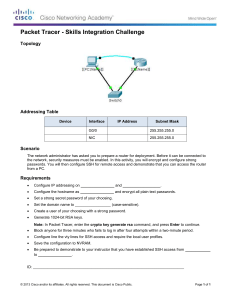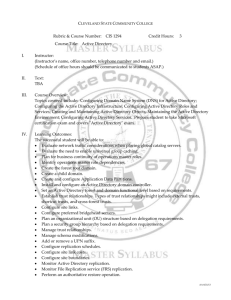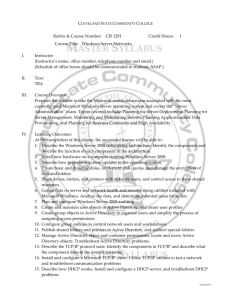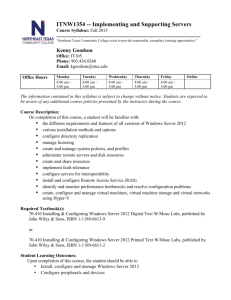70-640 - Galaxy Computer Education
advertisement
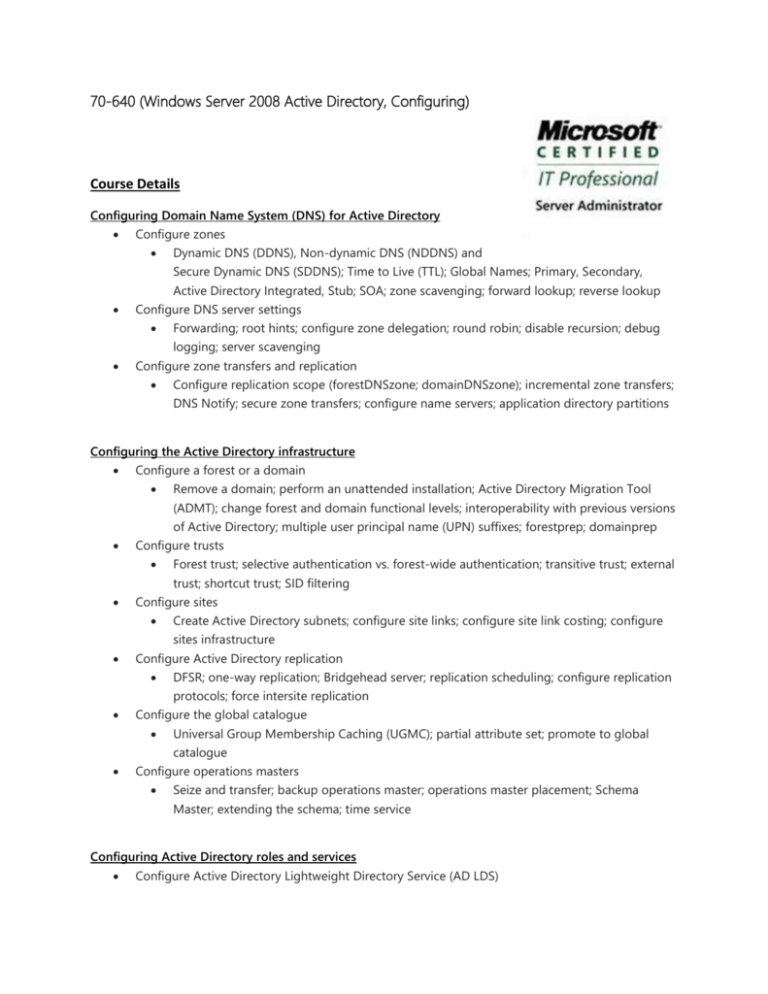
70-640 (Windows Server 2008 Active Directory, Configuring) Course Details Configuring Domain Name System (DNS) for Active Directory Configure zones Dynamic DNS (DDNS), Non-dynamic DNS (NDDNS) and Secure Dynamic DNS (SDDNS); Time to Live (TTL); Global Names; Primary, Secondary, Active Directory Integrated, Stub; SOA; zone scavenging; forward lookup; reverse lookup Configure DNS server settings Forwarding; root hints; configure zone delegation; round robin; disable recursion; debug logging; server scavenging Configure zone transfers and replication Configure replication scope (forestDNSzone; domainDNSzone); incremental zone transfers; DNS Notify; secure zone transfers; configure name servers; application directory partitions Configuring the Active Directory infrastructure Configure a forest or a domain Remove a domain; perform an unattended installation; Active Directory Migration Tool (ADMT); change forest and domain functional levels; interoperability with previous versions of Active Directory; multiple user principal name (UPN) suffixes; forestprep; domainprep Configure trusts Forest trust; selective authentication vs. forest-wide authentication; transitive trust; external trust; shortcut trust; SID filtering Configure sites Create Active Directory subnets; configure site links; configure site link costing; configure sites infrastructure Configure Active Directory replication DFSR; one-way replication; Bridgehead server; replication scheduling; configure replication protocols; force intersite replication Configure the global catalogue Universal Group Membership Caching (UGMC); partial attribute set; promote to global catalogue Configure operations masters Seize and transfer; backup operations master; operations master placement; Schema Master; extending the schema; time service Configuring Active Directory roles and services Configure Active Directory Lightweight Directory Service (AD LDS) Migration to AD LDS; configure data within AD LDS; configure an authentication server; Server Core installation Configure Active Directory Rights Management Service (AD RMS) Certificate request and installation; self-enrolments; delegation; create RMS templates; RMS administrative roles; RM add-on for IE Configure the read-only domain controller (RODC) Replication; Administrator role separation; read-only DNS; BitLocker; credential caching; password replication; syskey; read-only SYSVOL; staged install Configure Active Directory Federation Services (AD FSv2) Install AD FS server role; exchange certificate with AD FS agents; configure trust policies; configure user and group claim mapping; import and export trust policies Creating and maintaining Active Directory objects Automate creation of Active Directory accounts Bulk import; configure the UPN; create computer, user and group accounts (scripts, import, migration); template accounts; contacts; distribution lists; offline domain join Maintain Active Directory accounts Manage computer accounts; configure group membership; account resets; delegation; AGDLP/AGGUDLP; deny domain local group; local vs. domain; Protected Admin; disabling accounts vs. deleting accounts; deprovisioning; contacts; creating organisational units (OUs); delegation of control; protecting AD objects from deletion; managed service accounts Create and apply Group Policy objects (GPOs) Enforce, OU hierarchy, block inheritance and enabling user objects; group policy processing priority; WMI; group policy filtering; group policy loopback; Group Policy Preferences (GPP) Configure GPO templates User rights; ADMX Central Store; administrative templates; security templates; restricted groups; security options; starter GPOs; shell access policies Deploy and manage software by using GPOs Publishing to users; assigning software to users; assigning to computers; software removal; software restriction policies; AppLocker Configure account policies Domain password policy; account lockout policy; fine-grain password policies Configure audit policy by using GPOs Audit logon events; audit account logon events; audit policy change; audit access privilege use; audit directory service access; audit object access; advanced audit policies; global object access auditing; “Reason for Access” reporting Maintaining the Active Directory environment Configure backup and recovery Using Windows Server Backup; back up files and system state data to media; backup and restore by using removable media; perform an authoritative or non-authoritative restore; linked value replication; Directory Services Recovery Mode (DSRM); backup and restore GPOs; configure AD recycle bin Perform offline maintenance Offline defragmentation and compaction; Restartable Active Directory; Active Directory database mounting tool Monitor Active Directory Event viewer subscriptions; data collector sets; real-time monitoring; analysing logs; WMI queries; PowerShell Configuring Active Directory Certificate Services Install Active Directory Certificate Services Certificate authority (CA) types, including standalone, enterprise, root, and subordinate; role services; prepare for multiple-forest deployments Configure CA server settings Key archival; certificate database backup and restore; assigning administration roles; highvolume CAs; auditing Manage certificate templates Certificate template types; securing template permissions; managing different certificate template versions; key recovery agent Manage enrolments Network device enrolment service (NDES); auto enrolment; Web enrolment; extranet enrolment; smart card enrolment; authentication mechanism assurance; creating enrolment agents; deploying multiple-forest certificates; x.509 certificate mapping Manage certificate revocations Configure Online Responders; Certificate Revocation List (CRL); CRL Distribution Point (CDP); Authority Information Access (AIA)
